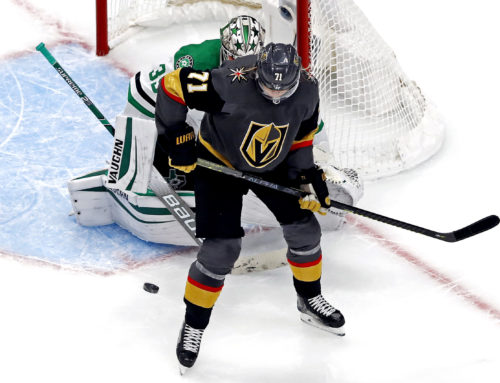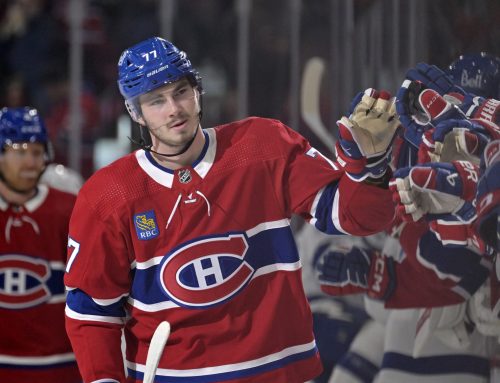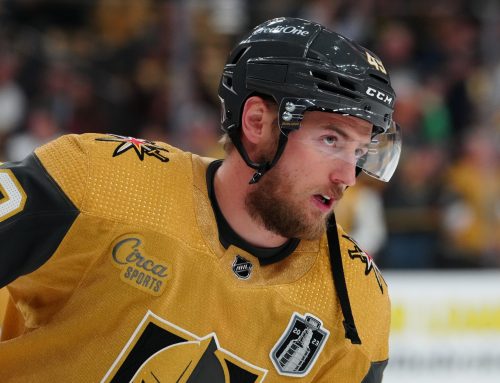Frozen Tool Forensics: Reviewing Breakout Predictions Like Pettersson And Moore
Chris Kane
2023-04-28
In keeping with our year in review theme, I want to return to a series I started back in August attempting to predict some players on the cusp of a breakout for 22-23. The premise was based on an article posted in June that attempted to define a breakout threshold in the NHL. The brief summary is that there tends to be a game count by which players start to break out. In this case breakout is defined as a 25 percent year-over-year increase. What they found is that average size forwards need about 200 games, and D and exceptionally small, or larger forwards need about 400 games.
My off-season analysis focused on one particular quote though that seemed very measurable.
"It’s always a great indicator if you see that a player finishes the previous season with 230 or 240 career games, and he just enjoyed a very strong second half. When you see that, then feel confident in a potential breakout for the year ahead."
It turns out I was able to translate that statement into variables we could export from the Dobber reports and we ended up with this list of recommended players. Not only did we recommend players who had a strong potential for a breakout, but we projected a pace given the breakout threshold was defined as a 25 percent year over year increase. The stats below are all as of August 2022 so don't take into account any games played in the 22-23 season.
| Name | Pos | Team | Total GP | Per Game PTS 1st Half | Per Game PTS 2nd Half | Δ in Splits | 21-22 Pt Pace | Proj 22-23 Pt Pace |
| ELIAS PETTERSSON | C | VAN | 245 | 0.5 | 1.2 | 0.7 | 70 | 87.5 |
| NICK SUZUKI | C | MTL | 209 | 0.5 | 0.9 | 0.4 | 61 | 76.25 |
| TAGE THOMPSON | C | BUF | 223 | 0.7 | 1 | 0.3 | 71 | 88.75 |
| MATHIEU JOSEPH | R | OTT | 232 | 0.3 | 0.6 | 0.3 | 36 | 45 |
| ROOPE HINTZ | C | DAL | 239 | 0.8 | 1 | 0.2 | 74 | 92.5 |
| TREVOR MOORE | R | L.A | 204 | 0.5 | 0.7 | 0.2 | 50 | 62.5 |
| ROBERT THOMAS | C | STL | 241 | 1 | 1.1 | 0.1 | 87 | 108.75 |
| CONOR GARLAND | L | VAN | 241 | 0.6 | 0.7 | 0.1 | 55 | 68.75 |
At the time of initial publishing, I added a few brief caveats to the list.
- Conor Garland and Robert Thomas barely saw improvement in the second half, but did technically so were included.
- Conor Garland and Roope Hintz are about an inch (in height) outside the general findings of the article but were still included.
- Robert Thomas and Tage Thompson had massive breakouts during the year so it wasn't entirely clear from our criteria if they should be counted as potential future breakouts (so given the 25% bump) or if they had already broken out and should just be expected to maintain.
We now have a completed season for the list so we can see how the group actually performed. For analysis purposes I am dividing the group into three categories. One group met or exceeded the 25 percent increase in point pace (bolded), one group increased, but did not exceed 25 percent, and the third decreased from the prior year (italicized).
| Name | Pos | Team | 21-22 Point Pace | Projected 22-23 Point Pace | Actual 22-23 Game Pace | GP | G | A | Pts | PPP | SOG | PP% | Total Time On Ice |
| TAGE THOMPSON | R | BUF | 71 | 89 | 99 | 78 | 47 | 47 | 94 | 34 | 297 | 61.7 | 18:35 |
| ELIAS PETTERSSON | C | VAN | 70 | 88 | 105 | 80 | 40 | 62 | 102 | 25 | 258 | 70.6 | 20:33 |
| ROOPE HINTZ | C | DAL | 74 | 93 | 84 | 73 | 37 | 38 | 75 | 21 | 184 | 58.8 | 17:33 |
| NICK SUZUKI | C | MTL | 61 | 76 | 66 | 82 | 26 | 40 | 66 | 17 | 162 | 67.7 | 21:06 |
| ROBERT THOMAS | C | STL | 87 | 109 | 73 | 73 | 18 | 47 | 65 | 22 | 106 | 60.1 | 19:21 |
| CONOR GARLAND | R | VAN | 55 | 69 | 47 | 81 | 17 | 29 | 46 | 12 | 167 | 28.4 | 15:07 |
| TREVOR MOORE | L | L.A | 50 | 63 | 40 | 59 | 10 | 19 | 29 | 7 | 163 | 37.4 | 16:59 |
| MATHIEU JOSEPH | L | OTT | 36 | 45 | 26 | 56 | 3 | 15 | 18 | 3 | 66 | 9.5 | 14:01 |
Overall, the group is split 50/50 for players that improved and players that did not, while a quarter for the group exceeded the breakout potential threshold. Let's start with the disappointments first.
Mathieu Joseph was only going to succeed if he maintained the huge boost in ice time that he got when he moved to Ottawa, and with all of the players Ottawa brought in during the offseason, that was pretty unlikely. It is hard to judge the success of the criteria on Joseph as a data point.
Robert Thomas and Conor Garland both had two caveats against them in the original article, so I suppose it isn't entirely surprising that they failed to reach their projected break out pace. I do briefly want to return to Robert Thomas though.
Thomas is an interesting case. He saw an increase in his overall ice time, an increase in his overall power-play role, maintained his shot rate, his shooting percentage, and put up more overall power-play points. By all accounts he should have at the very least maintained his 87-point pace from 21-22, and theoretically been poised to push it a little higher. The area that stands out is his underlying five on five numbers. Both his expected goal numbers, and his team shooting percentage dropped at five on five. Not catastrophically, but still fell. That was true on a full year basis, but also likely wasn't helped by the exodus of Blues talent to trades and injuries throughout the season. Everything about 22-23's pace seems potentially sustainable, which is great, but doesn't necessarily indicate another breakout is imminent.
A big part of Trevor Moore's breakout 50-point performance was a great fit on the second line in LA. In 23-23, he maintained that deployment for the most part. There was a little tinkering with Kevin Fiala entering the picture, and Moore himself spent some time injured. Like with Thomas, Moore saw career highs in time on ice, power-play percentage, and power-play points (though certainly not to the extent that we would have expected a huge season from him). He fell off of 21-22's pace in a lot of his underlying numbers though. Again, like with Thomas, both his expected goal numbers, and his team shooting percentage at five on five dropped. In addition to that though, he also dropped in his points participation. So, basically, he was less dangerous, his line was converting at a lower rate, and when they did score he was less likely to get in on it.
On to a couple of the exciting ones.
I don't think there is really much else to say about Tage Thompson at this point. It was a question mark for me whether he was going to continue the breakout, or level off like Robert Thomas, but for three quarters of the season he kept right on climbing. The only major concern is in his quarterly splits: Quarter One, 104-point pace; Quarter Two 129-point pace; Quarter Three 98-point pace; Quarter Four 58-point pace. Clearly one of these things is not like the others. He was dealing with or coming back from an injury during some of those games, so it remains to be seen if that was hampering him or if suddenly this magical almost two full seasons was catching up with him.
Roope Hintz didn't quite reach the 93-point projection, but managers will certainly take an 84-point pace. He did it over the shortened season as well but doing it over a full season certainly gives a lot of confidence going forward. There are some small fluctuations in the year-to-year underlying numbers for Hintz, but nothing alarming, and certainly nothing to indicate that he can't be a point per game player going forward. There is a question about what happens to Dallas' top line if Joe Pavelski is no longer there, but we shall cross that bridge when we come to it.
That is all for this week
Do your part to support organizations working to make hockey for everyone.





 WSH
WSH NYR
NYR NSH
NSH VAN
VAN COL
COL WPG
WPG L.A
L.A EDM
EDM CHI
CHI T.B
T.B CAR
CAR NYI
NYI S.J
S.J
